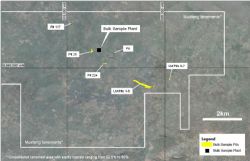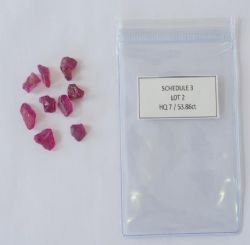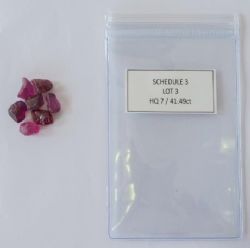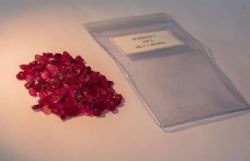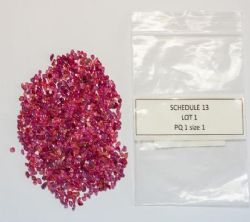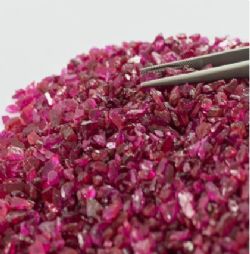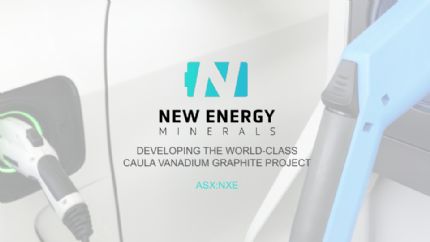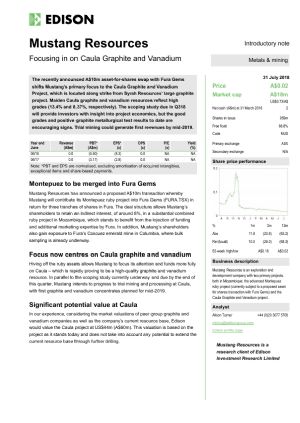 Ruby Operations and Strategy Update
Ruby Operations and Strategy Update
Sydney, Nov 16, 2017 AEST (ABN Newswire) - Mustang Resources Limited ("Mustang" or "the Company") ( ASX:MUS) (
ASX:MUS) ( GGPLF:OTCMKTS) has conducted an internal review of its recent first ruby auction and an assessment of its commercial and exploration strategy.
GGPLF:OTCMKTS) has conducted an internal review of its recent first ruby auction and an assessment of its commercial and exploration strategy.
The review was aimed at identifying the reasons for the auction results and the measures Mustang should adopt in order to ensure it can unlock the full underlying value of its Montepuez Ruby Project.
As a result of the review the following actions are being taken:
- the ruby grading system is being refined based on buyer feedback with further input from expert consultants
- the current ruby inventory (comprising 386,033 carats) is being re-graded
- selected rough ruby parcels from the re-graded inventory will be offered for sale in coming weeks and months in Asia in smaller auction formats
- bulk sampling activity will be suspended at the onset of the wet season (expected to be around the end November) and preference given to processing surface stockpiles which currently total 96,000 tonnes
- the exploration emphasis will shift towards lower-cost manual test pitting in order to establish a greater number of potential bulk sample test pit sites
- the artisanal miner development program (AMDP) has been temporarily suspended pending a review of revenues to be received from the sale of AMDP rubies
- opportunities to acquire additional prospective exploration tenements in the world-class Montepuez ruby field are being pursued.
BACKGROUND
From late 2015 until early 2017 Mustang acquired contractual rights to earn a majority interest in several prospecting and exploration licences in northern Mozambique considered highly prospective for high quality secondary ruby deposits. (see Note 1 below) Exploration ("Prospecting" as defined under the Mozambican mining legislation) commenced within the 193km2 tenement area in March 2016 and is ongoing.
The key focus of on-ground activity has been test pitting and larger-scale bulk sampling, supplemented by truck-mounted auger drilling. Multiple zones of gravel-hosted secondary ruby mineralisation have been discovered across the project area to date.
Mustang subsequently installed a bulk sampling plant (later upgraded to a capacity of 120 tonnes per hour referred to below) for a total cost of A$1,136,093 to date. This was a significant achievement for the Company given the short time since on ground activities began and for a capital cost which is thought to be significantly less than the capital costs for the adjacent plants (150tph and 250tph respectively) installed by Gemfields Plc.
Multiple challenges were overcome by the operational team during full commissioning. In late July 2017, the bulk sample processing plant was upgraded and sufficient processing water secured. This resulted in a rapid increase in ruby recoveries, with increased daily shifts and production records set for August and September 2017 of 14,775.80cts and 27,131cts respectively. (see Note 2 below)
It should be noted that the bulk sampling plant (although a capital expenditure item) must be regarded as an exploration and prospecting, not a mining, asset. Secondary gemstone deposits are, by their very nature, difficult to assess by conventional exploration techniques alone (e.g. drilling). Mustang's bulk sampling activities are necessary to provide information on and to analyse the quality and quantity of ruby mineralisation discovered by reconnaissance exploration programs.
Bulk Sampling Results
Exploration bulk sampling commenced at the Montepuez Ruby Project in late 2016.
To date 13 bulk sample pits have been excavated, 212,473 tonnes of gravels have been processed through the bulk sampling plant, and 74,090cts recovered.
Approximately 96,000 tonnes (61,935m3) of ruby-bearing gravels from various bulk sample pits remain to be processed from surface stockpiles next to the processing plant.
Preliminary reconciliation of the mined grade indicates that bulk sample pit grades generally ranged from 0.1cts per tonne washed to 0.5cts per tonne washed. The higher grades achieved were in the most recently excavated pits to the east of the bulk sampling plant (LM cuts 1 to 7). (see Note 3 below)
The locations of individual bulk sampling pits in relation to tenement boundaries and the Mustang bulk sampling plant is shown in Figure 1 (see link below).
Artisanal Miner Development Program (AMDP)
Unregulated and illegal artisanal mining activities (a strong indicator of ruby mineralisation) are widespread across the greater Montepuez district.
In early 2017 Mustang established an Artisanal Miner Development Program (AMDP) to provide illegal miners with more formalised arrangements to allow them to continue their activities on Mustang Resources' licence areas in a more efficient and safer manner. As part of the AMDP, Mustang has provided elementary washing and sorting equipment to the artisanal miners and logistical support for material transport.
Under the AMDP, Mustang engages constructively with the artisanal miners active on its licence areas and gathers invaluable information about the distribution of ruby mineralisation on its areas. The AMDP program has also enabled Mustang to engage with the local communities and community leaders and is generally welcomed and applauded by the Government and other authorities. The Company is proud of its corporate social responsibilities and achievements in these respects.
As at 31 October 2017, the AMDP has yielded 360,206cts, representing approximately 83% of total ruby yield for Mustang.
Mustang Grading System
There is no standard grading system established for the global ruby market. The buy-side of the industry is secretive, largely unregulated and fragmented. Many buyers have unique product requirements and are accustomed to sourcing stones from a diverse number of small miners and traders. In recent years, buyers have been able to source stones from Gemfields auctions centralised in Singapore. The ruby business worldwide is nonetheless still euphemistically known as an 'informal' or 'opaque' business when compared with more developed markets such as the diamond market.
Mustang developed a complex "proprietary" grading system for its alluvial stones in 2017. The grading system was developed in conjunction with specialist consultants with significant first-hand expertise and experience in ruby markets and with knowledge of ruby markets in Asia.
Mustang fully implemented its initial grading system in the lead-up to its maiden auction. The inventory was sorted into various sized parcels called 'lots' and then combined multiple lots into 'schedules' for the auction.
Mustang employees its own in-house gemmologists.
Special Stones
Through its ongoing Artisanal Miner Development Program (AMDP) Mustang recovered 11 large-sized stones and these were announced to the ASX in early 2017.
Five of these stones (which have come to be referred to as 'special stones') were sent as a test to Meg Berry in Tucson, Arizona, USA to be cut (faceted), polished and GIA-certified for possible future sale.
On 28 April 2017 Mustang announced a revised marketing strategy and stated that it did not intend to proceed with the sale of cut and polished stones because such sales would entail the Company being seen by prospective rough ruby buyers as competing with them in the same market. The cutting, polishing and certification of special stones was therefore suspended.
Mustang has no intention to enter the cut and polished stone market and the 5 'special stones' are therefore retained by the Company in safe and secure storage.
All other rough stones recovered by the Company sourced from either the bulk sampling program or the AMDP are uncut and were either sold at the October 2017 auction in Mauritius (the biggest being 14.24 carats) or included in rough ruby inventory for future sales.
October 2017 Auction Product Offering & Results
With the goal of gathering much-needed market intelligence on the Company's ruby inventory and to generate cash flow as early as possible, Mustang decided to make arrangements to host a rough ruby auction for a targeted 200,000 carats (by closed bid tender to engender maximum competition between buyers) in Mauritius at the end of October 2017, rather than pursue private sales or smaller auctions or tenders. This decision was based on inputs from expert industry consultants.
Having committed to such an auction, Mustang then needed to attract the attention of buyers to ensure strong attendance at the event.
Mustang aimed to present as many stones as possible across a wide variety of qualities for its initial auction as the first genuine market test and to gain as much market intelligence as possible.
Approvals from the Government of Mozambique for the export of stones to Mauritius and for sale at the auction for as many stones as possible were acquired.
The actual offering included a mix of high-quality schedules (each comprising multiple lots), "commercial" or lower quality schedules (comprising multiple lots), and one corundum lot totalling around 6,000cts. The offering comprised stones across the ruby to sapphire spectrum. (see Note 4 below)
Mustang offered for sale a total of 109 lots in the October 2017 auction.
Examples of lot types offered by Mustang are illustrated in Figure 2 (see link below).
It is not possible for the Company to report details of the auction results for individual lots (or schedules) due to confidentiality agreements with individual buyers and clear commercial-in-confidence constraints.
Total gross sales proceeds received or receivable by Mustang from the initial auction are A$713,456 at an average price of A$24.21 per carat. Prices realised for individual schedules sold ranged from A$6 per carat to A$1,944 per carat. (see Note 5 below)
Rough Ruby Inventory
As at 11 November 2017, Mustang held a rough ruby inventory totalling 386,033cts comprising unsold stones from the October 2017 auction and additional stones subsequently produced from operations in Mozambique.
The rough ruby inventory is held in safe house facilities.
Assessment of Auction Results
The Company has conducted a comprehensive review of the results of the October 2017 ruby auction in Mauritius and has identified a number of areas for improvement and re-configuration of future sales processes.
Buyer Feedback
Mustang management and marketing staff are continuing discussions to follow up with more than 40 different buyers comprising around 120 individuals who attended the auction, as well as prospective buyers who did not attend. The purpose is to gain a clearer and up-to-date understanding of each buyer's product requirements and to obtain other specific feedback on the Company's first auction.
Key feedback received to date is summarised as follows:
- the auction event in high security premises in Mauritius was very well organised and run in a very professional manner
- grading categories proved to be too broad and presented a broader-than-required mix of stones within each lot offered
- the offering did not include enough total volumes (whether in smaller or larger homogenous parcels) of stones across certain categories, in particular high-quality categories
- attractive prices will be paid by buyers for lower quality stones and such revenues can be substantial where volumes are large
- a number of buyers (some with more limited purchase requirements) expressed a preference for future sales to be held closer to their home base (primarily Asia), but not necessarily Singapore where Gemfields now dominates ruby auction sales
- the auction was held 27-30 October 2017, which proved to be just over one week before the dates of the Gemfields auctions re-arranged in Singapore for the second week of November 2017.
Grading System Enhancement
It is clear that the pre-auction grading of lots was too broadly implemented and resulted in overlaps between different qualities when viewed from a buyer's perspective. This, in turn, resulted in lower prices being bid by buyers on many of the lots. This factor has been identified as the single largest contributor to the 13 of the 21 schedules failing to meet reserve prices.
Steps have already been taken to correct this (through the in-house gemmology team) and the Company is confident that it can improve its actual grading processes and, through that, its clearance rates at future sales events.
Future Exploration and Prospecting Focus
As stated above, buyer feedback demonstrated that there was insufficient volume of stones across certain categories, in particular the higher quality categories. Buyers require a sufficient volume of stones to work with to allow them to meet their subsequent customers' jewellery manufacturing requirements.
Whilst the lower volume of high quality stones offered by Mustang did not preclude offers being made and accepted for lots in these categories, it is now clear that a more competitive auction environment would be facilitated by having a greater number of stones available within individual lots.
It is not considered feasible to extend the period between auctions to facilitate a greater build-up of inventory, as this would only unnecessarily delay receipt of revenues that can otherwise be directed back into ongoing exploration programs.
Feedback received from the auction has reiterated the strategy of targeting higher quality and higher grade ruby deposits. This has and will always be the core objective of the Company's exploration programs.
Further commentary on the Company's exploration programs is provided in subsequent sections of this announcement.
Sale Process Adjustments
A number of buyers have indicated a preference for Mustang to host subsequent sales closer to their home bases, predominantly in Asia, to reduce costs.
Test sales are to be competed in Asia in coming weeks and months and will provide Mustang with key feedback on the viability of supplementing its sales process with smaller, more focussed tenders, catering to specific buyer requirements.
In order to optimise the prices received for higher quality stones, Mustang will also seek to identify and target buyers with greater flexibility on purchase volume requirements.
Review of on ground Activities (Mozambique)
In the light of the auction results, the Company has conducted a review of on-ground activities in Mozambique and has identified several areas for re-configuration that will support the continuation of the Company's exploration programs across the highly prospective Montepuez ruby field.
Temporary Suspension of Bulk Sampling Activity
Mustang will cease all bulk sample extraction activity with the onset of the wet season around end-November and will save those costs.
However, the Company intends to supplement the existing inventory with rubies from the Company's existing 96,000 tonnes stockpiles (61,935m3) to be processed through the plant during the rainy season.
As stated above, the Company needs to complete the market test for prices over the full range of inventory qualities in order to be in a position to determine the extent of future of bulk sampling activities.
Once Mustang has these prices, the Company can proceed to analyse the cash break-even parameters (see Note 6 below) for bulk sampling operations and identify whether the Company should proceed with the LM series pits (refer Figure 1 in link below) or suspend mining until such time as potential higher grade and/or higher quality sources have been identified (refer commentary on exploration program below).
The analysis described above is fundamental to the overall review and assessment of the ruby activities.
Exploration and Prospecting Focus on Low Cost Methodologies
The primary objective of the Company's exploration programs is to delineate high quality and high grade ruby deposits.
As noted above the Company's primary exploration methodologies include: manual test pitting, auger drilling and large-scale bulk sampling. A description of each methodology, together with indicative cost and information acquired, is summarised in Table 1 (see link below).
Mustang has utilised all three primary exploration 'tools' within the Montepuez Ruby Project, supplemented by additional geological and geophysical programs.
It is apparent that manual test pitting is the most cost effective and rapid method of identifying the presence or absence of ruby mineralisation over a large footprint. Auger drilling also identifies the presence or absence of the gravel horizon but due to the small volume of sample collected (the diameter of the drill hole) it rarely provides a definitive assessment of the presence or absence of ruby mineralisation.
Due to the very inhomogeneous nature of ruby mineralisation neither manual test pitting nor auger drilling can provide definitive information on the overall grade of ruby mineralisation (carats per tonne) nor sufficient sample volumes to form a definitive view on ruby quality. In this regard, bulk sampling is essential to provide the necessary information to advance discoveries through Mineral Resource estimation and ultimately through to feasibility studies.
Having regard for the above the emphasis of Mustang's exploration programs will shift to the increased use of manual test pitting to seek to identify a greater range of possible bulk sampling targets for assessment.
Future bulk sampling activities will focus on the extraction of minimum parcel sizes from each bulk sample target (i.e. the minimum tonnage required to be processed through the bulk sample plant so as to be able to get an estimate of both ruby grade and ruby quality for each pit). This will provide for a more rapid and lower cost assessment of each individual ruby target.
Near term exploration activities will be focused in areas to the east of the processing plant considered by the Company to be more highly prospective for generation of additional bulk sampling targets for follow up after the rainy season. Some good rubies have also been found from test pitting on the southern border of 5030L so the search may cover this area as well.
It should be noted that the intensity of artisanal mining activity (also included in Table 1 in link below) is used by the Company as a strong indicator of prospective ruby mineralisation. The information gained from the assessment of artisanal mining activity is comparable in quality to that derived from the Company's manual test pitting program. Therefore, the identification and assessment of artisanal mining sites will also be used by the Company to build a portfolio of potential bulk sample sites.
Reassessment of the AMDP
The Company has built up significant information on project wide exploration prospectivity from the Artisanal Miner Development Program (AMDP).
As noted above the Company has commenced re-grading of its unsold lots, including stones from the AMDP.
Mustang is currently reviewing the AMDP program pending assessment of sales proceeds from sale of its full inventory but hopes to re-commence a full-scale AMDP in the near term.
Acquisition of Additional Prospective Ground
The Montepuez district is recognised as a world-class ruby field with ruby mineralisation now reported from multiple locations over very large area (see east-west 'ruby' trend in Figure 2 in link below). (see Note 7 below)
The widespread nature of ruby mineralisation indicates clear potential for the discovery of further high grade / high quality ruby deposits through ongoing exploration activities.
The Company is actively seeking opportunities to acquire an additional interest in highly prospective tenements in the region and is making some progress with targeted properties. The Company will continue to pursue such opportunities going forward.
Conclusion
The Company has achieved much in terms of becoming a new entrant to the international ruby business over the past 18 months. Barriers to entry have been significant and acquiring the necessary expertise, especially in marketing and sales, has been challenging.
The results of the Company's first ruby auction, being the first real market test, clearly fell short of the Company's hopes but presentation of the Company's inventory to the market is the only real mechanism for gaining accurate feedback on the value of the rubies being recovered.
The Company continues to hold the view that the Montepuez gem-field has world-class ruby prospectivity and that this prospectivity, combined with the continued demand growth for rubies, warrants the continuation of the Company's exploration program.
The Company's broad strategy with respect to its ruby projects remains unchanged and the Company's intention is to continue exploration on its current project area (and to seek additional project areas) through test pitting, drilling and bulk sampling and to sell recovered rough rubies to generate cash flow to support ongoing exploration and development costs. Ultimately, the Company still seeks to proceed to formal JORC Compliant Mineral Resource estimation and feasibility studies.
The outcome of these activities will determine if Mustang's Montepuez Ruby Project presents an opportunity for feasible long-term commercial development.
Having regard for the above the Company anticipates that near-term announcements by the Company in relation the Montepuez Ruby Project will focus on providing updates in the following key areas:
- results from the processing of surface stockpiles
- results from sales of selected rough ruby parcels from the re-graded inventory offered for sale in coming weeks and months in Asia in smaller auction formats
- results from ongoing exploration activities and
- announcements concerning the acquisition of new tenement areas across the Montepuez field.
In addition to the above, the Company continues to explore its high grade Caula Graphite Project for which a maiden Inferred Mineral Resource of 5.4Mt @13.0% TGC was announced to ASX on 7 November 2017, together with the attached JORC Table (see link below).
A new round of exploration drilling to commence this month and costed around A$500,000 has been proposed for the Caula Graphite Project (6678L) and on the adjacent licence area (5873L), with the view to expanding the existing Caula Inferred Resource, as well as testing key targets in the 18km TEM anomaly identified.
The Company will provide updates on its ruby and graphite activities to shareholders as results come to hand.
Notes:
1 Mustang interests in individual licences are 60.0% (4143L now 8921C); 52.5% (4285L); 52.5% (5030L); and 65.0% (8245L) and were acquired by shareholder-approved sale and purchase agreements with Regius Resources Group Ltd, a related party.
2 Reference should be made to the detailed information contained in the JORC Tables with respect to the Company's bulk sampling activities, which were attached to and in support of all of the Company's ruby announcements containing mineralisation statements. The most recent JORC Table was attached to the Company's September 2017 Quarterly Activities Report.
3 Reconciliation of mined grade is incomplete as all surface stockpiled material is yet to be processed. The term 'mined' as used in this announcement refers to activities associated with bulk sampling exploration activities and is not intended to represent commercial mining activities.
4 Note that there is no accepted standard industry definition for the distinction between rubies and sapphires and classification is problematic. Both gems are composed of Al2O3. A simplistic classification considers stones from red to pinkish red colour are rubies whilst stones that are lightish pink to blue in colour are sapphires. The lighting conditions and jewellery mounting medium have a significant impact on observed stone colours and hence perceived value. Pinkish rubies or pinkish sapphires have appeal to some buyers, especially for use by younger buyers, in preference to darker rubies.
5 Exchange rate 0.77 USD:AUD
6 This analysis will incorporate an assessment of the cut-off grade (carats per tonne) as well as the potential quality of the rubies.
7 Includes mineralisation reported within third party licence areas.
To view tables and figures, please visit:
http://abnnewswire.net/lnk/AEMD33AD
About New Energy Minerals Ltd
 New Energy Minerals Ltd (ASX:NXE) (FRA:GGY) is an ASX listed junior mining company, that recently announced the divestment of the Company's Caula vanadium - graphite project and the Montepuez Ruby project in Mozambique.
New Energy Minerals Ltd (ASX:NXE) (FRA:GGY) is an ASX listed junior mining company, that recently announced the divestment of the Company's Caula vanadium - graphite project and the Montepuez Ruby project in Mozambique.

![abnnewswire.com]()
Related Companies
Social Media
Share this Article

 ASX:MUS) (
ASX:MUS) ( GGPLF:OTCMKTS) has conducted an internal review of its recent first ruby auction and an assessment of its commercial and exploration strategy.
GGPLF:OTCMKTS) has conducted an internal review of its recent first ruby auction and an assessment of its commercial and exploration strategy.  New Energy Minerals Ltd (ASX:NXE) (FRA:GGY) is an ASX listed junior mining company, that recently announced the divestment of the Company's Caula vanadium - graphite project and the Montepuez Ruby project in Mozambique.
New Energy Minerals Ltd (ASX:NXE) (FRA:GGY) is an ASX listed junior mining company, that recently announced the divestment of the Company's Caula vanadium - graphite project and the Montepuez Ruby project in Mozambique.


